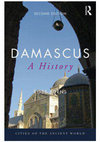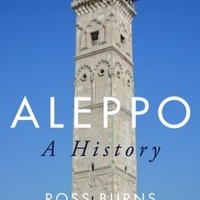Books by Ross A Burns

Table of Contents (revised edition 2019)
Abbreviations
List of Illustrations in the Text
Lis... more Table of Contents (revised edition 2019)
Abbreviations
List of Illustrations in the Text
List of Maps (after page …)
Foreword
Introduction
Four Roads to Damascus
The setting
Legends of a birth
For want of a spade
Chapter 1 – The Emergence of Damascus (9000 – c1000 BC)
The first villages
Ta-ms-qu in Upu
The mother of all battles
A wider catastrophe
Chapter 2 – Dimashqu – Damascus from the Aramaeans to the Assyrians (c1000 – 732 BC)
After the turmoil
An Aramaean Empire (Eleventh Century–733 BC)
Aram-Damascus vs Israel
Neo-Assyrian Empire (964–c800 BC)
The city of the god
Damascus in Aramaean Times
The temple
Resurgent Assyria (8th century BC)
Epilogue: An altar for Jerusalem
Chapter 3 – A Greater Game – Assyrians, Persians, Greeks (732 – c300 BC)
Neo-Assyrian Empire (732–636 BC)
Neo-Babylonians (Chaldeans) (626–539 BC)
Persian (Achaemenid) rule (539–333 BC)
Damascus during the twilight of the Ancient Near East
After Issus (333–331 BC)
A Hellenic millennium
Chapter 4 – The Sowing of Hellenism – Ptolemies and Seleucids (300 – 64 BC)
Ptolemaic rule – Third Century BC
Damascus between rival dynasties
Seleucid rule – second century BC
The persistence of the plan
A Greek city
Temple of Zeus
A Hellenistic civilisation?
Chapter 5 – Towards a Pax Romana (64 BC – AD 30)
Rome Intervenes
Pompey’s settlement
The east Mediterranean theatre
Damascus and the struggle for empire
Stabilising the Damascus region
Urge to monumentalise
Civic works
Chapter 6 – Metropolis Romana (AD 30 – 268)
Who were the Syrians?
The city and temple of Jupiter
Importance of cult centres
First Christian mission
An imperial city
Syrian consorts
The eastern question
Population
City and country
Chapter 7 – Holding the Line (AD 269 – 610)
Nature of the Persian threat
Hard and soft frontiers
A Christian city
Cathedral of Saint John
Decline and disintegration
Who were the Arabs|?
‘Do it yourself’ defence doctrine
Chapter 8 – ‘Farewell, Oh Syria’ (611 – 661)
Damascus – The First Bulwark
The great field army perishes
Arab aims
Heraclius retreats
Arab administration
Chapter 9 – The Umayyads (661 – 750)
Muʿawiya and the new order
The Umayyad prism
The ʿAlite revolt
Acquisition of the Church of Saint John
The building of the Mosque
The fantastic garden
Threshold of Paradise
A ninety year empire
A glorious failure?
PART TWO
Preface to Part Two - When did the ancient end?
Chapter 10 – Decline, Confusion and Irrelevance (750 – 1008)
Ostracism (750–877)
Teaching Damascus a lesson
Sullen revolt
Turkish inroads, Tulunids (877–905)
Shiʿism
Fragmentation (905–964)
Fatimids (969–1071)
Seljuks (1055–1104)
Arrival of the Burids (1104)
First madrasas
Chapter 11 – Islam Resurgent (1098 – 1174)
Bulwark Against the Crusaders?
Early Burids (Tughtagin 1104–28)
Burids versus Zengids (1128–48)
Jerusalem-Damascus-Aleppo
The Second Crusade (1148) – ‘Fiasco’
Citadel of the faith
Jihad!
Nur al-Din (1154–74)
Nur al-Din’s monuments
A new ‘Golden Age’
Chapter 12 – Saladin and the Ayyubids (1174 – 1250)
Saladin’s rise
Hattin (1187)
‘The last victory’
The Ayyubid succession
Al-Muazzim ʿIssa (1218–28)
Jerusalem betrayed
Al-Ashraf (1229–38)
Back on the periphery (1238-50)
Courtly society
Chapter 13 – Mamluks (1250 – 1515)
The Central Asian threat
Baybars (1260–77)
Return of the Mongols
The Mamluk system
A new prosperity
Foreigners
Mamluk building
Tengiz’s governorship (1312– 40)
Decline (1341-82)
Burji Mamluks (1382–1516)
Siege of Tamerlane (1401)
A Venetian window
Collapse
Chapter 14 – The Ottoman Centuries (1516 – 1840)
Military rule
The Hajj
Midan
Stability of population
Reshaping Damascus
Municipal services
A new role (1706–58)
‘Age of the Aʿyans’
Cathedrals of commerce
Acre’s rise – and fall
European ambitions – Egypt intervenes
Chapter 15 – Reform and Reaction (1840 – 1918)
Tanzimat – reform and reaction
1860 massacre
A ‘Little Istanbul’
Telegraph, road and rail
To Mecca by train?
The great fire of 1893
Suq al-Hamidiye
The Damascus house
Command for monument protection
Arab awakening
‘To Damascus!’ – the great ride
Whose Damascus?
Chapter 16 Epilogue – Countdown to Catastrophe (1919–2011)
1919
1925
1948
1970
2011
Appendices
Glossary of Terms and Names
Maps of City and Environs
Bibliography
Index

Many of the major and mid-ranking cities of the Greek-speaking East under Rome adopted the cross-... more Many of the major and mid-ranking cities of the Greek-speaking East under Rome adopted the cross-city colonnaded axis as the central unifying element of their urban layout. This book seeks to explain the origin of the idea. Earlier studies, usually treating the issues briefly in the course of more general surveys, have identified possible origins in the Greek and Roman architectural traditions (the Greek stoa or the Roman porticus). Others have traced roots stemming from the Pharaonic or Achaemenid traditions. This study looks at the whole range of ideas on urban development prevalent in the Eastern provinces under Rome in the first two centuries of the Empire (up to AD 150), including the use of monumental architecture to implant Roman authority amidst the diverse political structures of the Eastern provinces. It seeks to identify whether the first colonnaded axis (Antioch)—attested in the writings of Josephus and attributed to Herod the Great in the early Augustan period—was replicated in the intervening decades before the axis suddenly became a common element of the town plans of most major cities and many minor ones in the early second century AD.
The study looks at possible ‘missing’ examples of street colonnading in the first century AD and at the complementary idea of a straight and wide cross-city axis, which had some precedents in both Greek and Egyptian town layouts. It concludes that the adoption of the colonnaded axis in the Eastern provinces is a reflection of a diverse range of architectural and town planning practices in the region at the time, over which Rome sought to impose only a weak centralizing influence. A few examples of the colonnaded axis did emerge in the first century, but the idea was given new impetus by the introduction in the second century AD of a more centralized architectural vocabulary. This went hand in hand with the reorganization of the system for the mining and transporting of materials and the associated concentration in a few places of the expertise required for such massive projects. The colonnaded street was not specifically a tool of what would once have been called ‘Romanization’, but by the second century AD it was to become an indicator of cities’ attachment to the Roman system. It was the product of the collective inventiveness of the architects, builders, patrons, and administrators operating within a system that allowed ideas to flow freely, tolerated experi-mentation and a sense of competition between urban centres, provided the right administrative and legal systems to protect the use of public spaces, and could assemble massive amounts of material efficiently.
Aleppo is one of the longest-surviving cities of the ancient and Islamic Middle East. Its tangle ... more Aleppo is one of the longest-surviving cities of the ancient and Islamic Middle East. Its tangle of streets still follow the Hellenistic grid and above it looms the great Citadel, which contains recently-uncovered remains of a Bronze/Iron Age temple complex, suggesting an even earlier role as a ‘high place’ in the Canaanite tradition.
In this volume, Ross Burns explores the rich history of this important city, from its earliest history through to the modern era, providing a thorough treatment of this fascinating city history, accessible both to scholarly readers as well as to the general public interested in a factual and comprehensive survey of the city’s past.
The Monuments of Syria (third edition 2009)
Monuments of Syria is essential reading for those interested in the variety of archaeological rem... more Monuments of Syria is essential reading for those interested in the variety of archaeological remains and historical sites in Syria. Published originally in 1992, it quickly became the indespinsible reference work presenting some 132 sites, buildings or urban itineraries accompanied by references for further reading, local details, with building or sites plans in many cases and an atlas of the main historical regions of Syria.
Background and drafts by Ross A Burns
Update on damage to historic monuments in Syria
Updated and consolidated list of assessed damage to historic monuments in Syria.
Conference Presentations by Ross A Burns
Syria is the world’s greatest outdoor museum—richer in its variety and coverage than any other na... more Syria is the world’s greatest outdoor museum—richer in its variety and coverage than any other nation.
Syria’s heritage is large part of the jigsaw of world cultures.
Much has been said over the past six years on the destruction of Syria’s archaeological heritage. Yet the level of destruction barely rivals the toll the conflict has taken on lives of the country’s citizens and its housing stock.
This talk will seek to use the examples of Aleppo and Palmyra to show how the pattern of destruction has varied from place to place reflecting the intricate nature of the conflict. It will also underline that virtually all parties to the fighting have sought to use the country’s monuments as either weapons or propaganda tools in the confrontation.
Historical Atlas of Syria (draft) by Ross A Burns
Supplement to the Draft Historical of Syria and neighbouring regions
This sheet has been added to the draft atlas for Syria to show the southern region of the Anti-Le... more This sheet has been added to the draft atlas for Syria to show the southern region of the Anti-Lebanon in the context of the Lebanon Range to the west
Draft Historical Atlas of Syria and neighbouring regions, sheet 00 coverage
Draft Historical Atlas of Syria, sheet 01 Barada Valley, 2019
Syria, a draft historical atlas—sheet 01, the Valley of the Barada River from Zabadani to Damascus
Draft Historical Atlas of Syria, sheet 02 Hauran
Archaeological and historical sites in the Hauran region of southern Syria
Syria historical atlas, sheet 03 Golan plateau, from Mt Hermon to the Yarmuk River
Syria historical atlas, sheet 03 Golan plateau, from Mt Hermon to the Yarmuk River
Draft historical atlas of Syria, sheet 4 Damascus to Palmyra
Syria historical atlas, sheet 04—Damascus to Palmyra
Atlas of Syrian Historical Geography, sheet 05 South and East of Aleppo
This sheet covers the Syrian steppe country between the Aleppo to Homs highway and the desert oas... more This sheet covers the Syrian steppe country between the Aleppo to Homs highway and the desert oases including Palmyra.
Draft historical atlas, sheet 06—the Mid-Euphrates / Khabur basin
Draft historical atlas of Syria—sheet 06, the Valley of the Mid-Euphrates (Raqqa to Abu Kemal) an... more Draft historical atlas of Syria—sheet 06, the Valley of the Mid-Euphrates (Raqqa to Abu Kemal) and the Khabur River (Syrian Jazira)
Syria draft historical atlas Mid-Euphrates Valley Jerabulus to Raqqa
Draft historical atlas of Syria, Valley of the Mid-Euphrates River from Jerabulus to Raqqa and th... more Draft historical atlas of Syria, Valley of the Mid-Euphrates River from Jerabulus to Raqqa and the Khabur River system
A draft Atlas of Syrian History, sheet 08 west of Aleppo
This map covers the long range of hilly country west of Aleppo. Once known popularly as the 'Dead... more This map covers the long range of hilly country west of Aleppo. Once known popularly as the 'Dead Cities', the area comprises a series of limestone hills.
Syria Draft Historical Atlas, sheet 8a—Limestone Massif, Jebel Semaan
The first of three detailed sheets of the Limestone Massif (or 'Dead Cities') zone of northern Sy... more The first of three detailed sheets of the Limestone Massif (or 'Dead Cities') zone of northern Syria covers the Jebel Semaan or Mountain of Simeon
This second of the detailed sheets of the region known as the Limestone Massif (or 'Dead Cities')... more This second of the detailed sheets of the region known as the Limestone Massif (or 'Dead Cities') of northern Syria covers the central hilly areas including the Jebel al-`Ala, Jebel Barisha and part of the Jebel Halaqa. Most of the area covered lies south of the main highway from Aleppo to Antioch.
The third detailed sheet of the coverage for the Limestone Massif of northern Syria covers the so... more The third detailed sheet of the coverage for the Limestone Massif of northern Syria covers the southern areas known as the Jebel Zawiya, Jebel Riha and Jebel Shahshabu. The coverage includes the countryside south of the Aleppo to Latakia highway (M4) and extends as far as Apamea on the edge of the Orontes Valley.











Uploads
Books by Ross A Burns
Abbreviations
List of Illustrations in the Text
List of Maps (after page …)
Foreword
Introduction
Four Roads to Damascus
The setting
Legends of a birth
For want of a spade
Chapter 1 – The Emergence of Damascus (9000 – c1000 BC)
The first villages
Ta-ms-qu in Upu
The mother of all battles
A wider catastrophe
Chapter 2 – Dimashqu – Damascus from the Aramaeans to the Assyrians (c1000 – 732 BC)
After the turmoil
An Aramaean Empire (Eleventh Century–733 BC)
Aram-Damascus vs Israel
Neo-Assyrian Empire (964–c800 BC)
The city of the god
Damascus in Aramaean Times
The temple
Resurgent Assyria (8th century BC)
Epilogue: An altar for Jerusalem
Chapter 3 – A Greater Game – Assyrians, Persians, Greeks (732 – c300 BC)
Neo-Assyrian Empire (732–636 BC)
Neo-Babylonians (Chaldeans) (626–539 BC)
Persian (Achaemenid) rule (539–333 BC)
Damascus during the twilight of the Ancient Near East
After Issus (333–331 BC)
A Hellenic millennium
Chapter 4 – The Sowing of Hellenism – Ptolemies and Seleucids (300 – 64 BC)
Ptolemaic rule – Third Century BC
Damascus between rival dynasties
Seleucid rule – second century BC
The persistence of the plan
A Greek city
Temple of Zeus
A Hellenistic civilisation?
Chapter 5 – Towards a Pax Romana (64 BC – AD 30)
Rome Intervenes
Pompey’s settlement
The east Mediterranean theatre
Damascus and the struggle for empire
Stabilising the Damascus region
Urge to monumentalise
Civic works
Chapter 6 – Metropolis Romana (AD 30 – 268)
Who were the Syrians?
The city and temple of Jupiter
Importance of cult centres
First Christian mission
An imperial city
Syrian consorts
The eastern question
Population
City and country
Chapter 7 – Holding the Line (AD 269 – 610)
Nature of the Persian threat
Hard and soft frontiers
A Christian city
Cathedral of Saint John
Decline and disintegration
Who were the Arabs|?
‘Do it yourself’ defence doctrine
Chapter 8 – ‘Farewell, Oh Syria’ (611 – 661)
Damascus – The First Bulwark
The great field army perishes
Arab aims
Heraclius retreats
Arab administration
Chapter 9 – The Umayyads (661 – 750)
Muʿawiya and the new order
The Umayyad prism
The ʿAlite revolt
Acquisition of the Church of Saint John
The building of the Mosque
The fantastic garden
Threshold of Paradise
A ninety year empire
A glorious failure?
PART TWO
Preface to Part Two - When did the ancient end?
Chapter 10 – Decline, Confusion and Irrelevance (750 – 1008)
Ostracism (750–877)
Teaching Damascus a lesson
Sullen revolt
Turkish inroads, Tulunids (877–905)
Shiʿism
Fragmentation (905–964)
Fatimids (969–1071)
Seljuks (1055–1104)
Arrival of the Burids (1104)
First madrasas
Chapter 11 – Islam Resurgent (1098 – 1174)
Bulwark Against the Crusaders?
Early Burids (Tughtagin 1104–28)
Burids versus Zengids (1128–48)
Jerusalem-Damascus-Aleppo
The Second Crusade (1148) – ‘Fiasco’
Citadel of the faith
Jihad!
Nur al-Din (1154–74)
Nur al-Din’s monuments
A new ‘Golden Age’
Chapter 12 – Saladin and the Ayyubids (1174 – 1250)
Saladin’s rise
Hattin (1187)
‘The last victory’
The Ayyubid succession
Al-Muazzim ʿIssa (1218–28)
Jerusalem betrayed
Al-Ashraf (1229–38)
Back on the periphery (1238-50)
Courtly society
Chapter 13 – Mamluks (1250 – 1515)
The Central Asian threat
Baybars (1260–77)
Return of the Mongols
The Mamluk system
A new prosperity
Foreigners
Mamluk building
Tengiz’s governorship (1312– 40)
Decline (1341-82)
Burji Mamluks (1382–1516)
Siege of Tamerlane (1401)
A Venetian window
Collapse
Chapter 14 – The Ottoman Centuries (1516 – 1840)
Military rule
The Hajj
Midan
Stability of population
Reshaping Damascus
Municipal services
A new role (1706–58)
‘Age of the Aʿyans’
Cathedrals of commerce
Acre’s rise – and fall
European ambitions – Egypt intervenes
Chapter 15 – Reform and Reaction (1840 – 1918)
Tanzimat – reform and reaction
1860 massacre
A ‘Little Istanbul’
Telegraph, road and rail
To Mecca by train?
The great fire of 1893
Suq al-Hamidiye
The Damascus house
Command for monument protection
Arab awakening
‘To Damascus!’ – the great ride
Whose Damascus?
Chapter 16 Epilogue – Countdown to Catastrophe (1919–2011)
1919
1925
1948
1970
2011
Appendices
Glossary of Terms and Names
Maps of City and Environs
Bibliography
Index
The study looks at possible ‘missing’ examples of street colonnading in the first century AD and at the complementary idea of a straight and wide cross-city axis, which had some precedents in both Greek and Egyptian town layouts. It concludes that the adoption of the colonnaded axis in the Eastern provinces is a reflection of a diverse range of architectural and town planning practices in the region at the time, over which Rome sought to impose only a weak centralizing influence. A few examples of the colonnaded axis did emerge in the first century, but the idea was given new impetus by the introduction in the second century AD of a more centralized architectural vocabulary. This went hand in hand with the reorganization of the system for the mining and transporting of materials and the associated concentration in a few places of the expertise required for such massive projects. The colonnaded street was not specifically a tool of what would once have been called ‘Romanization’, but by the second century AD it was to become an indicator of cities’ attachment to the Roman system. It was the product of the collective inventiveness of the architects, builders, patrons, and administrators operating within a system that allowed ideas to flow freely, tolerated experi-mentation and a sense of competition between urban centres, provided the right administrative and legal systems to protect the use of public spaces, and could assemble massive amounts of material efficiently.
In this volume, Ross Burns explores the rich history of this important city, from its earliest history through to the modern era, providing a thorough treatment of this fascinating city history, accessible both to scholarly readers as well as to the general public interested in a factual and comprehensive survey of the city’s past.
Background and drafts by Ross A Burns
Conference Presentations by Ross A Burns
Syria’s heritage is large part of the jigsaw of world cultures.
Much has been said over the past six years on the destruction of Syria’s archaeological heritage. Yet the level of destruction barely rivals the toll the conflict has taken on lives of the country’s citizens and its housing stock.
This talk will seek to use the examples of Aleppo and Palmyra to show how the pattern of destruction has varied from place to place reflecting the intricate nature of the conflict. It will also underline that virtually all parties to the fighting have sought to use the country’s monuments as either weapons or propaganda tools in the confrontation.
Historical Atlas of Syria (draft) by Ross A Burns
Abbreviations
List of Illustrations in the Text
List of Maps (after page …)
Foreword
Introduction
Four Roads to Damascus
The setting
Legends of a birth
For want of a spade
Chapter 1 – The Emergence of Damascus (9000 – c1000 BC)
The first villages
Ta-ms-qu in Upu
The mother of all battles
A wider catastrophe
Chapter 2 – Dimashqu – Damascus from the Aramaeans to the Assyrians (c1000 – 732 BC)
After the turmoil
An Aramaean Empire (Eleventh Century–733 BC)
Aram-Damascus vs Israel
Neo-Assyrian Empire (964–c800 BC)
The city of the god
Damascus in Aramaean Times
The temple
Resurgent Assyria (8th century BC)
Epilogue: An altar for Jerusalem
Chapter 3 – A Greater Game – Assyrians, Persians, Greeks (732 – c300 BC)
Neo-Assyrian Empire (732–636 BC)
Neo-Babylonians (Chaldeans) (626–539 BC)
Persian (Achaemenid) rule (539–333 BC)
Damascus during the twilight of the Ancient Near East
After Issus (333–331 BC)
A Hellenic millennium
Chapter 4 – The Sowing of Hellenism – Ptolemies and Seleucids (300 – 64 BC)
Ptolemaic rule – Third Century BC
Damascus between rival dynasties
Seleucid rule – second century BC
The persistence of the plan
A Greek city
Temple of Zeus
A Hellenistic civilisation?
Chapter 5 – Towards a Pax Romana (64 BC – AD 30)
Rome Intervenes
Pompey’s settlement
The east Mediterranean theatre
Damascus and the struggle for empire
Stabilising the Damascus region
Urge to monumentalise
Civic works
Chapter 6 – Metropolis Romana (AD 30 – 268)
Who were the Syrians?
The city and temple of Jupiter
Importance of cult centres
First Christian mission
An imperial city
Syrian consorts
The eastern question
Population
City and country
Chapter 7 – Holding the Line (AD 269 – 610)
Nature of the Persian threat
Hard and soft frontiers
A Christian city
Cathedral of Saint John
Decline and disintegration
Who were the Arabs|?
‘Do it yourself’ defence doctrine
Chapter 8 – ‘Farewell, Oh Syria’ (611 – 661)
Damascus – The First Bulwark
The great field army perishes
Arab aims
Heraclius retreats
Arab administration
Chapter 9 – The Umayyads (661 – 750)
Muʿawiya and the new order
The Umayyad prism
The ʿAlite revolt
Acquisition of the Church of Saint John
The building of the Mosque
The fantastic garden
Threshold of Paradise
A ninety year empire
A glorious failure?
PART TWO
Preface to Part Two - When did the ancient end?
Chapter 10 – Decline, Confusion and Irrelevance (750 – 1008)
Ostracism (750–877)
Teaching Damascus a lesson
Sullen revolt
Turkish inroads, Tulunids (877–905)
Shiʿism
Fragmentation (905–964)
Fatimids (969–1071)
Seljuks (1055–1104)
Arrival of the Burids (1104)
First madrasas
Chapter 11 – Islam Resurgent (1098 – 1174)
Bulwark Against the Crusaders?
Early Burids (Tughtagin 1104–28)
Burids versus Zengids (1128–48)
Jerusalem-Damascus-Aleppo
The Second Crusade (1148) – ‘Fiasco’
Citadel of the faith
Jihad!
Nur al-Din (1154–74)
Nur al-Din’s monuments
A new ‘Golden Age’
Chapter 12 – Saladin and the Ayyubids (1174 – 1250)
Saladin’s rise
Hattin (1187)
‘The last victory’
The Ayyubid succession
Al-Muazzim ʿIssa (1218–28)
Jerusalem betrayed
Al-Ashraf (1229–38)
Back on the periphery (1238-50)
Courtly society
Chapter 13 – Mamluks (1250 – 1515)
The Central Asian threat
Baybars (1260–77)
Return of the Mongols
The Mamluk system
A new prosperity
Foreigners
Mamluk building
Tengiz’s governorship (1312– 40)
Decline (1341-82)
Burji Mamluks (1382–1516)
Siege of Tamerlane (1401)
A Venetian window
Collapse
Chapter 14 – The Ottoman Centuries (1516 – 1840)
Military rule
The Hajj
Midan
Stability of population
Reshaping Damascus
Municipal services
A new role (1706–58)
‘Age of the Aʿyans’
Cathedrals of commerce
Acre’s rise – and fall
European ambitions – Egypt intervenes
Chapter 15 – Reform and Reaction (1840 – 1918)
Tanzimat – reform and reaction
1860 massacre
A ‘Little Istanbul’
Telegraph, road and rail
To Mecca by train?
The great fire of 1893
Suq al-Hamidiye
The Damascus house
Command for monument protection
Arab awakening
‘To Damascus!’ – the great ride
Whose Damascus?
Chapter 16 Epilogue – Countdown to Catastrophe (1919–2011)
1919
1925
1948
1970
2011
Appendices
Glossary of Terms and Names
Maps of City and Environs
Bibliography
Index
The study looks at possible ‘missing’ examples of street colonnading in the first century AD and at the complementary idea of a straight and wide cross-city axis, which had some precedents in both Greek and Egyptian town layouts. It concludes that the adoption of the colonnaded axis in the Eastern provinces is a reflection of a diverse range of architectural and town planning practices in the region at the time, over which Rome sought to impose only a weak centralizing influence. A few examples of the colonnaded axis did emerge in the first century, but the idea was given new impetus by the introduction in the second century AD of a more centralized architectural vocabulary. This went hand in hand with the reorganization of the system for the mining and transporting of materials and the associated concentration in a few places of the expertise required for such massive projects. The colonnaded street was not specifically a tool of what would once have been called ‘Romanization’, but by the second century AD it was to become an indicator of cities’ attachment to the Roman system. It was the product of the collective inventiveness of the architects, builders, patrons, and administrators operating within a system that allowed ideas to flow freely, tolerated experi-mentation and a sense of competition between urban centres, provided the right administrative and legal systems to protect the use of public spaces, and could assemble massive amounts of material efficiently.
In this volume, Ross Burns explores the rich history of this important city, from its earliest history through to the modern era, providing a thorough treatment of this fascinating city history, accessible both to scholarly readers as well as to the general public interested in a factual and comprehensive survey of the city’s past.
Syria’s heritage is large part of the jigsaw of world cultures.
Much has been said over the past six years on the destruction of Syria’s archaeological heritage. Yet the level of destruction barely rivals the toll the conflict has taken on lives of the country’s citizens and its housing stock.
This talk will seek to use the examples of Aleppo and Palmyra to show how the pattern of destruction has varied from place to place reflecting the intricate nature of the conflict. It will also underline that virtually all parties to the fighting have sought to use the country’s monuments as either weapons or propaganda tools in the confrontation.
There is no need co go more than a few metres in Damascus co find yourself captive of its past. We take here only a short section (200 metres) of the route that lies between Bayt al-Aqqad and the Umayyad Mosque. The route (see fig. 1)is one that will often be taken by the visitor co the Bayt aJ-Aqqad. It links the busiest part of Straight Street not only co the Great Mosque of the Umayyads co the north but also to the main western axis leading co the Mosque, the Suq al-Hamidiye. The Hamidiye Suq is the most prestigious of the late Otcoman city's shopping precincts and still one of the most enticing thoroughfares of any Middle Eastern city.